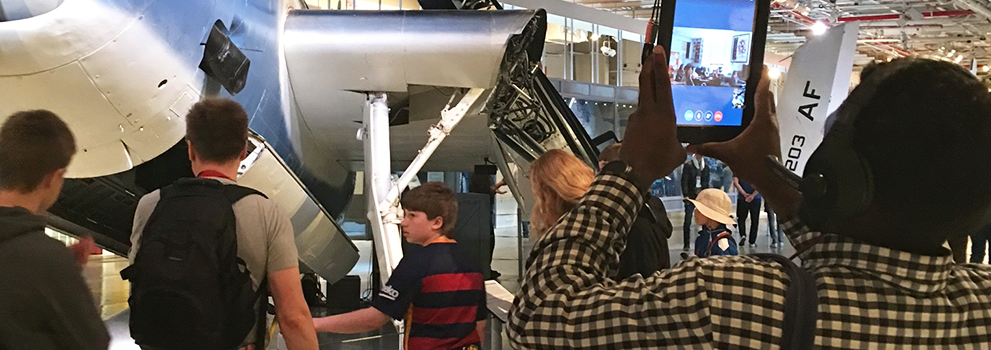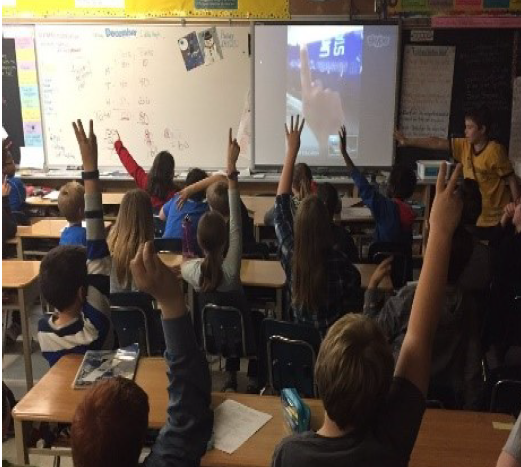Virtual field trips bring New York City museum to students around the world

For many students, going on a field trip is a school memory they will look back on for years. Getting out of the classroom and exploring a new place is exciting and offers a great chance for hands-on learning.
But not all students are given this opportunity. With limited school budgets, field trips aren’t always possible.
New York City’s Intrepid Sea, Air & Space Museum, centered on the aircraft carrier the USS Intrepid, is making field trips a reality for more students through a program called Virtual Field Trips — an innovative distance learning model using video conference calls. Visitors explore the ship and other exhibits that combine history and STEM.
A recent STEM Action Grant from the Society for Science & the Public is helping to bring that experience to students around the world, regardless of location. The grant has allowed the Intrepid Museum to deliver 58 virtual field trips over the last six months, serving 2,128 students in classrooms around the world.

“With virtual field trips, we are able to give individuals an authentic museum experience,” said Frantz Lucien, Museum Educator for Community Engagement at the Intrepid Museum.
“My mom is a teacher, one of the biggest complaints is that during the school year, dealing with standardized testing, there aren’t many opportunities to leave the classroom,” Frantz said.
In addition to providing virtual field trips for schools, the Intrepid Museum also offers programs for juvenile detention centers, libraries, community centers, senior centers, and more.
Erin Phillips, Director of Grants and Foundation Relations, explained that virtual field trips can open doors for students.
“When the Museum launched the Virtual Field Trips program two years ago, we saw early success, but also knew that the program had the potential to make a much larger impact,” Erin explained. “The STEM Action Grant has been instrumental in helping expand the program to reach more students, and evaluate the program to determine what content is most meaningful and engaging. Further, the Museum is on the path to becoming a model for best practices in virtual programming.”
Many students might never have the opportunity to set foot in the museum in New York City, but the virtual field trips make exploring a new world possible.
On June 25, third through fifth graders from Meadow Lane Elementary School in Lee’s Summit, Missouri sat cross-legged in the middle of their classroom, eyes glued to a computer screen. On the other end of the line, over a thousand miles away, Frantz was a friendly face showing them the view outside of the museum, the Hudson River, and spouting interesting facts about space capsule replicas and airplanes.
“That is awesome bro!” elementary schoolers shouted.
Throughout the virtual field trip, the students screamed in excitement and raised their hands to ask questions — just like if they were on an in-person field trip.
For part of the virtual field trip, Frantz recreated the vacuum of space with a bell jar experiment. Inside the vacuum, a marshmallow expanded and then quickly contracted. The students asked Frantz to eat it, and he complied, noting that it was a bit crunchy since it had evaporated water inside. Other experiments invovled inflated and deflated balloons and a cup of water, which bubbled inside the vacuum but never became hot.
Another stop along the journey was a model version of the Intrepid, which is made of 250,000 Lego pieces, weighs 500 pounds, and took an entire year to build.
“I think my favorite part is the cultural significance,” Frantz said. “What really sticks out is the fact that students will never make it to New York City, whether due to distance or socioeconomic factors. But with the virtual field trips, they feel like they are in New York City. We show them the New York City skyline and sometimes they can see the Empire State Building.”
“Virtual field trips help us take the museum to places that need it,” Frantz said.
For more information on Distance Learning at the Intrepid Museum, contact educationevents@intrepidmuseum.org.


